Influence of Housing and Management on Claw Health in Swiss Dairy Goats
Abstract
Simple Summary
Abstract
1. Background
2. Methods
2.1. Farms and Animals
2.2. Data Collection
2.3. Claw Conditions
- A.
- Toe length: Distance between the dorsal coronary band and the apex of the digit.
- B.
- Heel height: Vertical distance from the sole to the coronary band at the extreme plantar or palmar margin of the heel on the floor.
- C.
- Sole length: Length of the abaxial wall and bulb that are in contact with the floor surface.
- D.
- Sole width (lateral and medial digit): Largest distance between the abaxial and axial wall at the sole–heel junction of each digit.
2.4. Claw Lesions
2.5. Lying Behavior and Locomotor Activity
2.6. Statistical Analysis
3. Results
3.1. Claw Measurements
3.2. Wall Horn Overgrowth
3.3. Slipper Foot
3.4. Claw Lesions
3.4.1. Sole Hemorrhages
3.4.2. Horn Separation
3.4.3. Bleeding
3.5. Locomotion
4. Discussion
5. Conclusions
Supplementary Materials
Author Contributions
Funding
Institutional Review Board Statement
Data Availability Statement
Acknowledgments
Conflicts of Interest
References
- Miller, B.A.; Lu, C.D. Current status of global dairy goat production: An overview. Asian-Australas. J. Anim. Sci. 2019, 32, 1219–1232. [Google Scholar] [CrossRef]
- Park, Y.W. Hypo-allergenic and therapeutic significance of goat milk. Small Rumin. Res. 1994, 14, 151–159. [Google Scholar] [CrossRef]
- International Diabetes Federation. The World Dairy Situation 2017. In Bulletin of International Dairy Federation 489/2017; IDF: Brussels, Belgium, 2017. [Google Scholar]
- Food and Agriculture Organization of the United Nations. Statistical Databases. Available online: http://www.fao.org/statistics/en/ (accessed on 5 May 2020).
- McGonegal, M. Dairy goats in Ontario: A growing industry. In Canadian Agriculture at a Glance; Statistics Canada: Ottawa, ON, Canada, 2017; Available online: https://www150.statcan.go.ca/n1/pub/96-325-x/2017001/article/54873-eng.html (accessed on 30 April 2020).
- Herren, U. Schweizerischer Ziegenzuchtverband Jahresbericht 2018 [Swiss Goat Breeders Association Annual Report 2018]; Schweizerischer Ziegenzuchtverband: Zollikofen, Switzerland, 2019. [Google Scholar]
- TSM; Schweizer Milchproduzenten; Switzerland Cheese Marketing; Branchenorganisation Milch; Agristat. Milchstatistik der Schweiz 2018 [Dairy statistics Switzerland 2018]; Schweizer Bauernverband: Brugg, Switzerland, 2019; Available online: https://www.sbv-usp.ch/de/services/agristat/milchstatistic/ (accessed on 29 April 2020).
- Escareño, L.; Salinas-Gonzalez, H.; Wurzinger, M.; Iñiguez, L.; Sölkner, J.; Meza-Herrera, C. Dairy goat production systems: Status quo, perspectives and challenges. Trop. Anim. Health Prod. 2012, 45, 17–34. [Google Scholar] [CrossRef]
- Zobel, G.; Neave, H.W.; Webster, J. Understanding natural behavior to improve dairy goat (Capra hircus) management systems. Transl. Anim. Sci. 2018, 3, 212–224. [Google Scholar] [CrossRef]
- Popescu, A. Study refarding the trends in the World and European goat milk production. Lucr. Stiintifice Ser. Zootehine 2013, 59, 127–132. [Google Scholar]
- Hill, N.P.; Murphy, P.E.; Nelson, A.J.; Mouttotou, N.; Green, L.E.; Morgan, K.L. Lameness and foot lesions in adult British dairy goats. Vet. Rec. 1997, 141, 412–416. [Google Scholar] [CrossRef]
- Christodoulopoulos, G. Foot lameness in dairy goats. Res. Vet. Sci. 2009, 86, 281–284. [Google Scholar] [CrossRef] [PubMed]
- Anzuino, K.; Bell, N.J.; Bazeley, K.J.; Nicol, C.J. Assessment of welfare on 24 commercial UK dairy goat farms based on direct observations. Vet. Rec. 2010, 167, 774–780. [Google Scholar] [CrossRef] [PubMed]
- Kofler, J. Klauenpflege bei Schaf und Ziege [Claw trimming on sheep and goat]. Klauentrierpraxis 2016, 24, 61–68. [Google Scholar]
- Gautam, M.; Stevenson, M.A.; Lopez-Villalobos, N.; McLean, V. Risk factors for culling, sales and deaths in New Zealand dairy goat herds, 2000–2009. Front. Vet. Sci. 2017, 4, 191–198. [Google Scholar] [CrossRef]
- Molares, F.A.; Genis, J.; Mena, Y. Current status, challenges and the way forward for dairy goat production in Europe. Asian-Australs. J. Anim. Sci. 2019, 32, 1256–1265. [Google Scholar]
- Lu, C.D.; Miller, B.A. Current status, challenges and prospects for dairy goat production in the Americas. Asian-Australs. J. Anim. Sci. 2019, 32, 1244–1255. [Google Scholar] [CrossRef]
- Ibrahim, A.; Mahmoud, U.T.; Khalil, N.S.A.; Hussein, H.A.; Ali, M.M. A pilot study on surgical trimming impact on severely overgrown claws in sheep: Behavioral, physiological, and ruminal function aspects. J. Vet. Behav. 2018, 23, 66–75. [Google Scholar] [CrossRef]
- Smith, M.C.; Sherman, D.M. Goat Medicine, 2nd ed.; Blackwell Science: Oxford, UK, 2009. [Google Scholar]
- Groenevelt, M.; Anzuino, K.; Langton, D.A.; Grogono-Thomas, R. Association of treponeme species with atypical foot lesions in goats. Vet. Rec. 2015, 176, 626. [Google Scholar] [CrossRef]
- Crosby-Durrani, H.E.; Clegg, S.R.; Singer, E.; Angell, J.W.; Evans, N.J.; Carter, S.D.; Blundell, R.J.; Duncan, J.S. Severe foot lesions in dairy goats associated with digital dermatitis treponemes. J. Comp. Pathol. 2016, 154, 283–296. [Google Scholar] [CrossRef]
- Aguiar, G.M.N.; Simões, S.V.D.; Silva, T.R.; Assis, A.C.O.; Medeiros, J.M.A.; Garino, F., Jr.; Riet-Correa, F. Foot rot and other foot diseases of goat and sheep in the semiarid region of northeastern Brazil. Pesqui Vet. Brasil. 2011, 31, 879–884. [Google Scholar] [CrossRef]
- Laven, R. Use of parenteral long-acting and topical oxytetracycline, without hoof trimming, for treatment of footrot in goats. N. Z. Vet. J. 2012, 60, 213–214. [Google Scholar] [CrossRef]
- Bennett, G.; van Loenen, A.; Zhou, H.; Sedcole, R.; Hickford, J. The detection of Dichelobacter nodosus and Fusobacterium necrophorum from footrot lesions in New Zealand goats. Anaerobe 2009, 15, 177. [Google Scholar] [CrossRef]
- Mohamadnia, A.; Khaghani, A. Evaluation of hooves’ morphometric parameters in different hoof trimming times in dairy cows. Vet. Res. Forum. 2013, 4, 245–249. [Google Scholar]
- van der Tol, P.P.J.; van der Beek, S.S.; Metz, J.H.M.; Noordhuizen-Stassen, E.N.; Back, W.; Braam, C.R.; Weijs, W.A. The effect of preventive trimming on weight bearing and force balance on the claws of dairy cattle. J. Dairy Sci. 2004, 87, 1732–1738. [Google Scholar] [CrossRef]
- Kaler, J.; Medley, G.F.; Grogono-Thomas, R.; Wellington, E.M.H.; Calvo-Bado, L.A.; Wassink, G.J.; King, E.M.; Moore, L.J.; Russell, C.; Green, L.E. Factors associated with changes of state of foot conformation and lameness in a flock of sheep. Prev. Vet. Med. 2010, 97, 237–244. [Google Scholar] [CrossRef]
- Boettcher, P.J.; Jairath, L.K.; Koots, K.R.; Dekkers, J.C.M. Effects of interactions between type and milk production on survival traits of Canadian Holsteins. J. Dairy Sci. 1997, 80, 2984–2995. [Google Scholar] [CrossRef]
- Koluman, N.; Göncü, S. Measurements of healthy hooves, their interrelation and correlation with body mass in some improved goat breeds. Int. J. Agric. Environ. Biotechnol. 2016, 1, 108–116. [Google Scholar]
- Grenho Gonçalves Ajuda, I.; Battini, M.; Stilwell, G.T. The role of claw deformation and claw size on goat lameness. Vet. Anim. Sci. 2019, 8, 100080. [Google Scholar] [CrossRef] [PubMed]
- Quirk, T.J. Excel 2016 for Social Science Statistics: A Guide to Solving Practical Problems, 1st ed.; Springer: Heidelberg, Germany, 2016. [Google Scholar]
- Bhardwaj, V.; Dhungyel, O.P.; de Silva, K.; Dhand, N.K.; Whittngton, R.J. An objective method for assessment of foot conformation in sheep. Small Rumin. Res. 2018, 167, 22–28. [Google Scholar] [CrossRef]
- Lottner, S. Felduntersuchung zur Bekämpfung der Moderhinke bei Schafen Mittels Vakzinen und Genetischer Marker [Field Study for Fighting Foot Rot in Sheep by Means of Vaccines and Genetic Markers]. Ph.D. Thesis, University of Veterinary Medicine Hannover, Hannover, Germany, 2006. [Google Scholar]
- Winter, A.C. Treatment and control of hoof disorders in sheep and goats. Vet. Clin. N. Am. Food Anim. Pract. 2011, 27, 187–192. [Google Scholar] [CrossRef] [PubMed]
- Strobel, H. Klauenpflege Schaf und Ziege [Claw Trimming Sheep and Goat], 2nd ed.; Eugen Ulmer KG: Stuttgart, Germany, 2014. [Google Scholar]
- Katsoulos, P.-D.; Giadinis, N.D.; Chaintoutis, S.C.; Dovas, C.I.; Kiossis, E.; Tsousis, G.; Psychas, V.; Vlemmas, I.; Papadopoulos, T.; Papadopoulos, O.; et al. Epidemiological characteristics and clinicopathological features of bluetongue in sheep and cattle, during the 2014 BTV serotype 4 incursion in Greece. Trop. Anim. Health Prod. 2016, 48, 469–477. [Google Scholar] [CrossRef] [PubMed]
- ICAR Working Group on Functional Traits and International Claw Health Experts. (Ed.) ICAR Claw Health Atlas, 1st ed.; International Committee for Animal Recording: Rome, Italy, 2015. [Google Scholar]
- Winter, A.C. Lameness in sheep. Small Rumin. Res. 2008, 76, 149–153. [Google Scholar] [CrossRef]
- Stäuble, A.; Steiner, A.; Frey, J.; Kuhnert, P. Simultaneous detection and discrimination of virulent and benign Dichelobacter nodosus in sheep of flocks affected by foot rot and in clinically healthy flocks by competitive real-time PCR. J. Clin. Microbiol. 2014, 52, 1228–1231. [Google Scholar] [CrossRef][Green Version]
- Stachowicz, J.; Gygax, L.; Hillmann, E.; Wechsler, B.; Keil, N.M. Dairy goats use outdoor runs of high quality more regardless of the quality of indoor housing. Appl. Anim. Behav. Sci. 2018, 208, 22–30. [Google Scholar] [CrossRef]
- Egli, P. Aktivitätsverhalten von Milch- und Zwergziegen [Activity Behaviour of Dairy and Dwarf Goats]. Master’s Thesis, Swiss Federal Institute of Technology, Zurich, Switzerland, 2018. [Google Scholar]
- Bates, D.; Mächler, M.; Bolker, B.; Walker, S. Fitting linear mixed-effects models using lme4. J. Stat. Softw. 2015, 67, 48. [Google Scholar] [CrossRef]
- Halekoh, U.; Højsgaard, S. A Kenward–Roger approximation and parametric bootstrap methods for tests in linear mixed models—the R package pbkrtest. J. Stat. Softw. 2014, 59, 32. [Google Scholar] [CrossRef]
- Grenho Ajuda, I.; Vieira, A.; Stilwell, G. Are there differences in dairy goats claws’ temperature, before and after trimming? In Proceedings of the IEEE International Symposium on Medical Measurements and Applications, Lisbon, Portugal, 11–12 June 2014.
- Van der Tol, P.P.J.; Metz, J.H.M.; Noordhuizen-Stassen, E.N.; Back, W.; Braam, C.R.; Weijs, W.A. The vertical ground reaction force and the pressure distribution on the claws of dairy cow while walking on flat substrate. J. Dairy Sci. 2003, 86, 2875–2883. [Google Scholar] [CrossRef]
- Gelasakis, A.I.; Kalogianni, A.I.; Bossis, I. Aetiology, risk factors, diagnosis and control of foot-related lameness in dairy sheep. Animals 2019, 9, 509. [Google Scholar] [CrossRef]
- Winter, A. Treatment of toe granuloma in sheep. In Practice. 1997, 19, 214–215. [Google Scholar] [CrossRef]
- Hodgkinson, O. The importance of feet examination in sheep health management. Small Rumin. Res. 2010, 92, 67–71. [Google Scholar] [CrossRef]
- Ardüser, F.; Moore-Jones, G.; Gobeli Brawand, S.; Dürr, S.; Steiner, A.; Ryser-Degiorgis, M.-P.; Zanolari, P. Dichelobacter nodosus in sheep, cattle, goats and South American camelids in Switzerland—assessing prevalence in potential hosts in order to design targeted disease control measures. Prev. Vet. Med. 2020, 178, 104688. [Google Scholar]
- Barroso, F.G.; Alados, C.L.; Boza, J. Social hierachy in the domestic goat: Effect on food habits and production. Appl. Anim. Behav. Sci. 2000, 69, 35–53. [Google Scholar] [CrossRef]

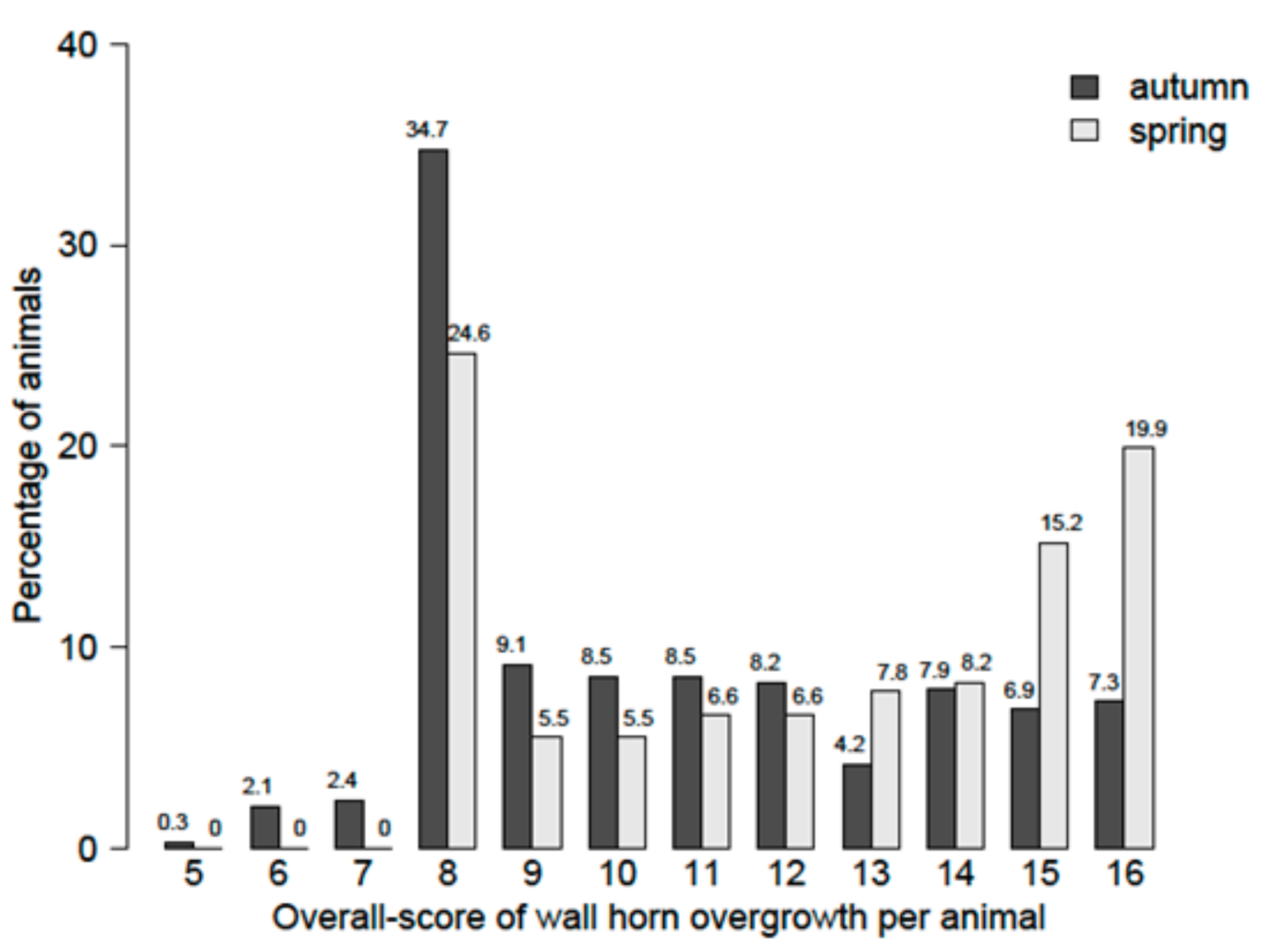

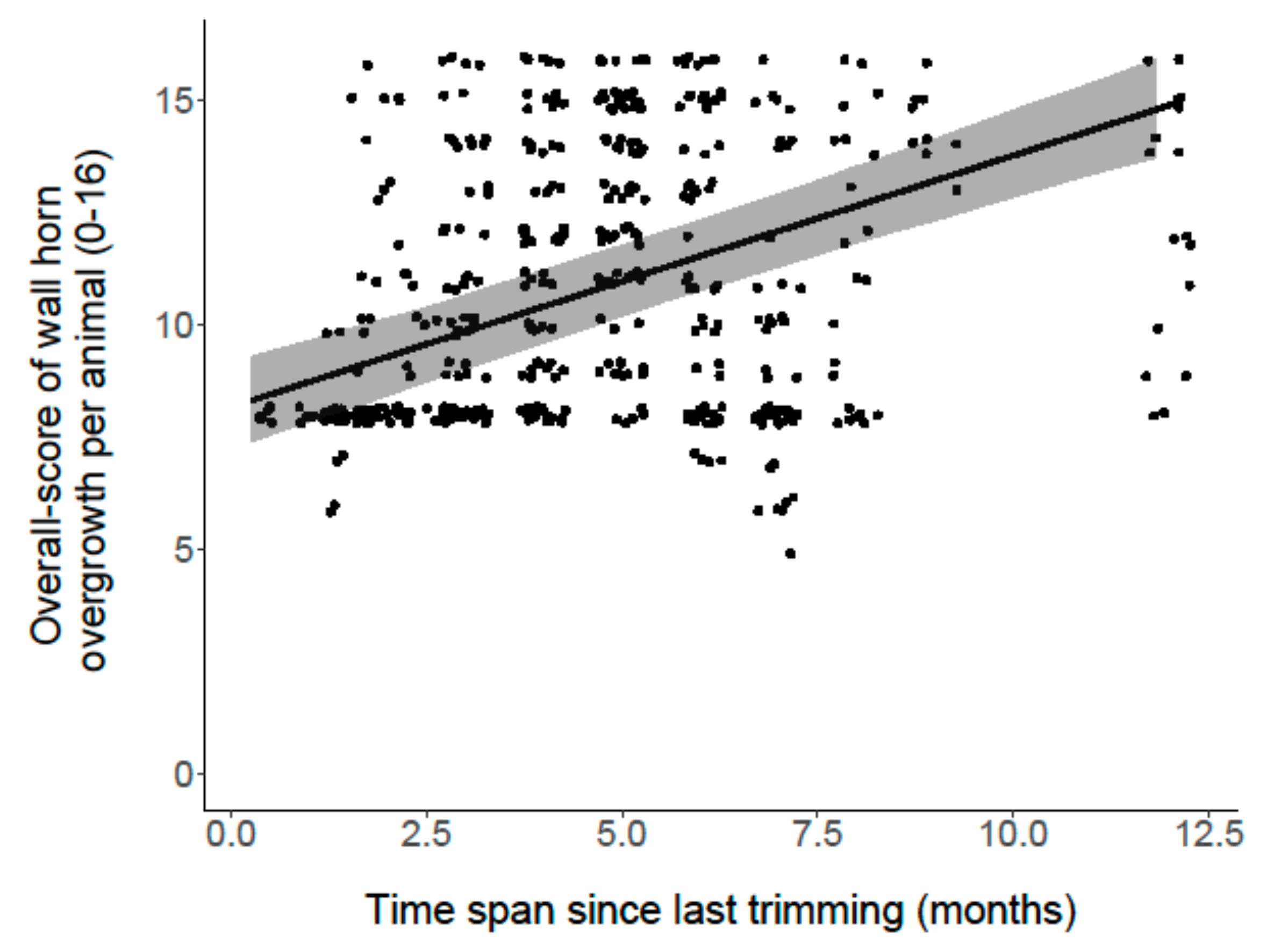
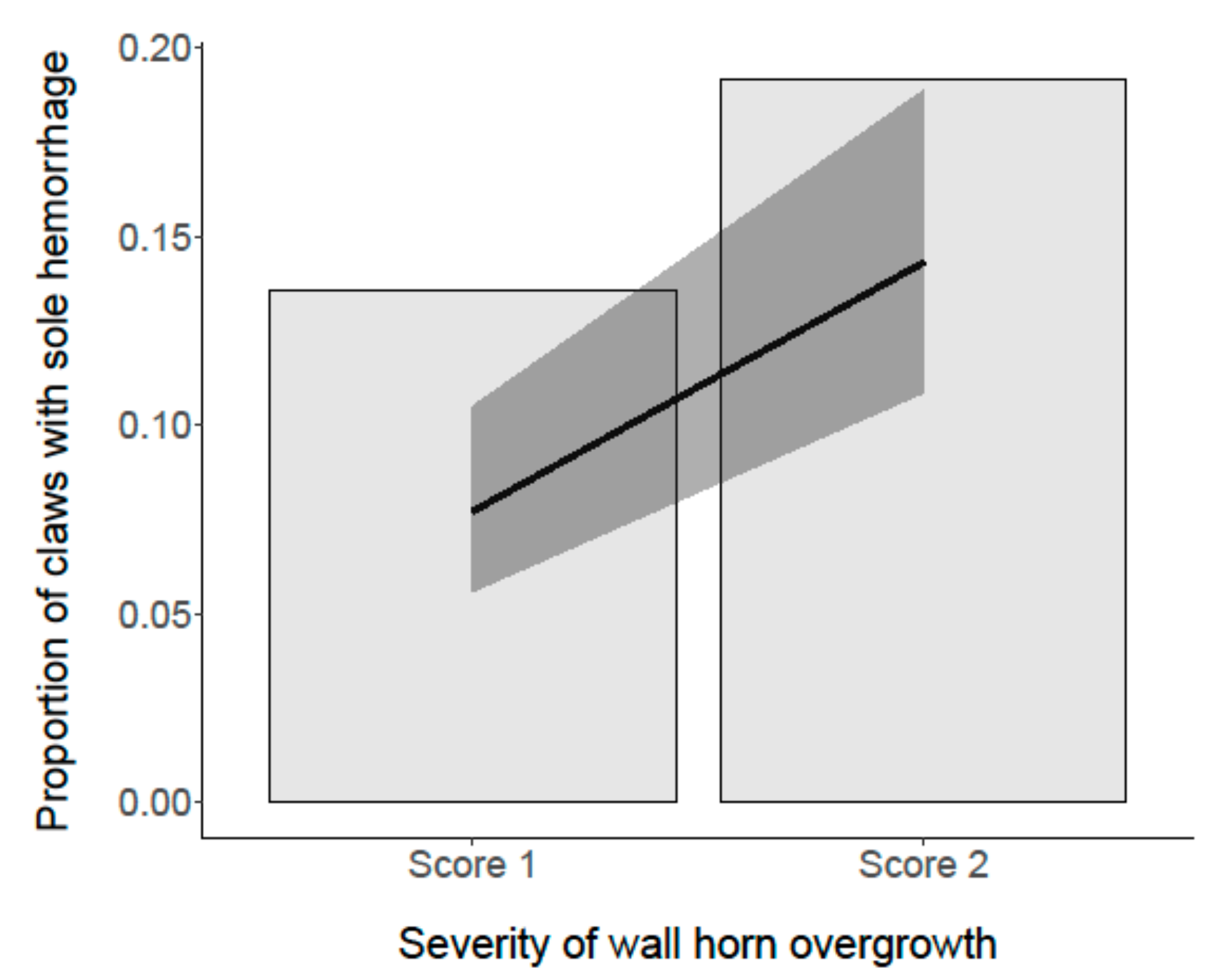
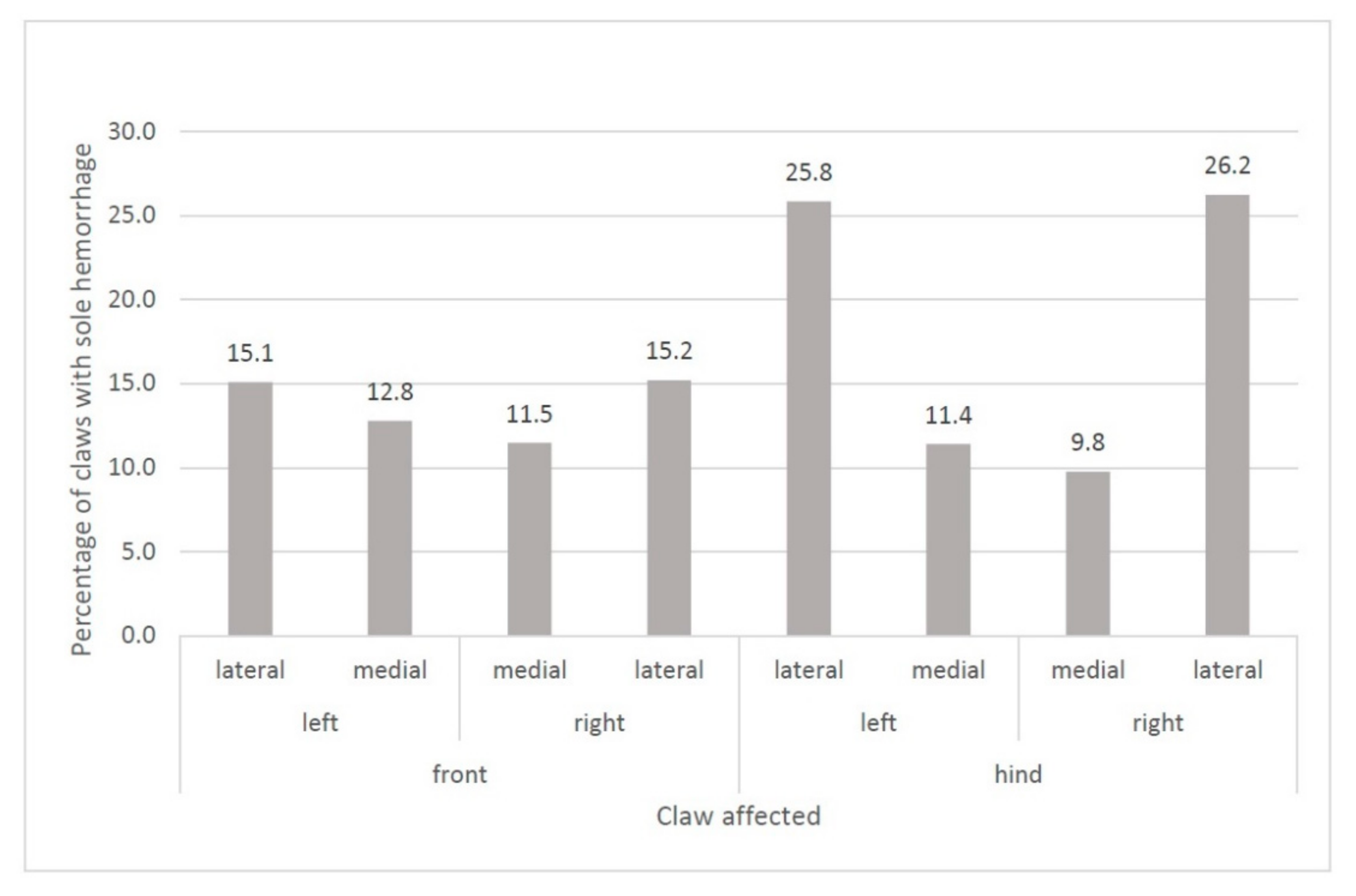
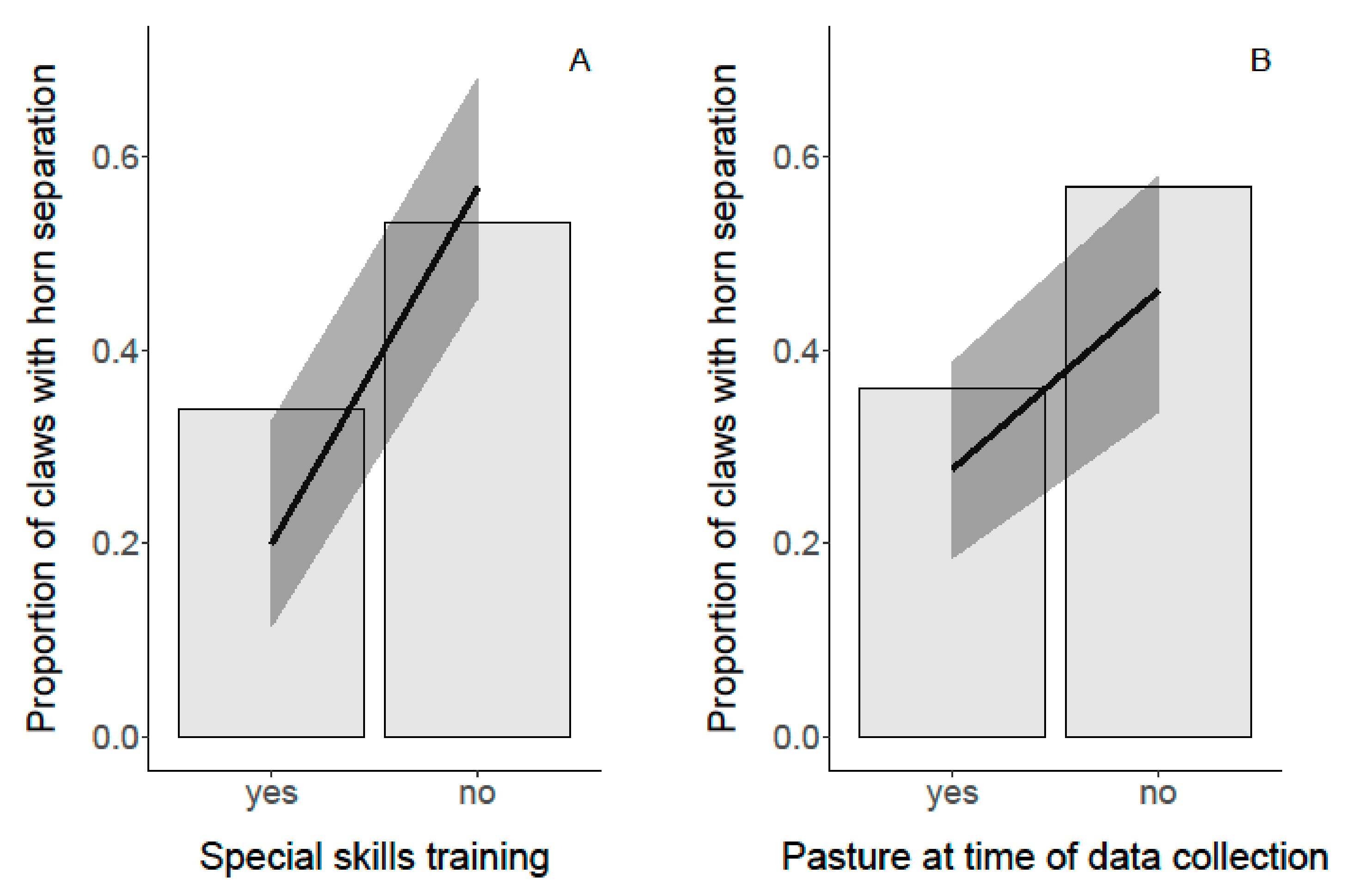
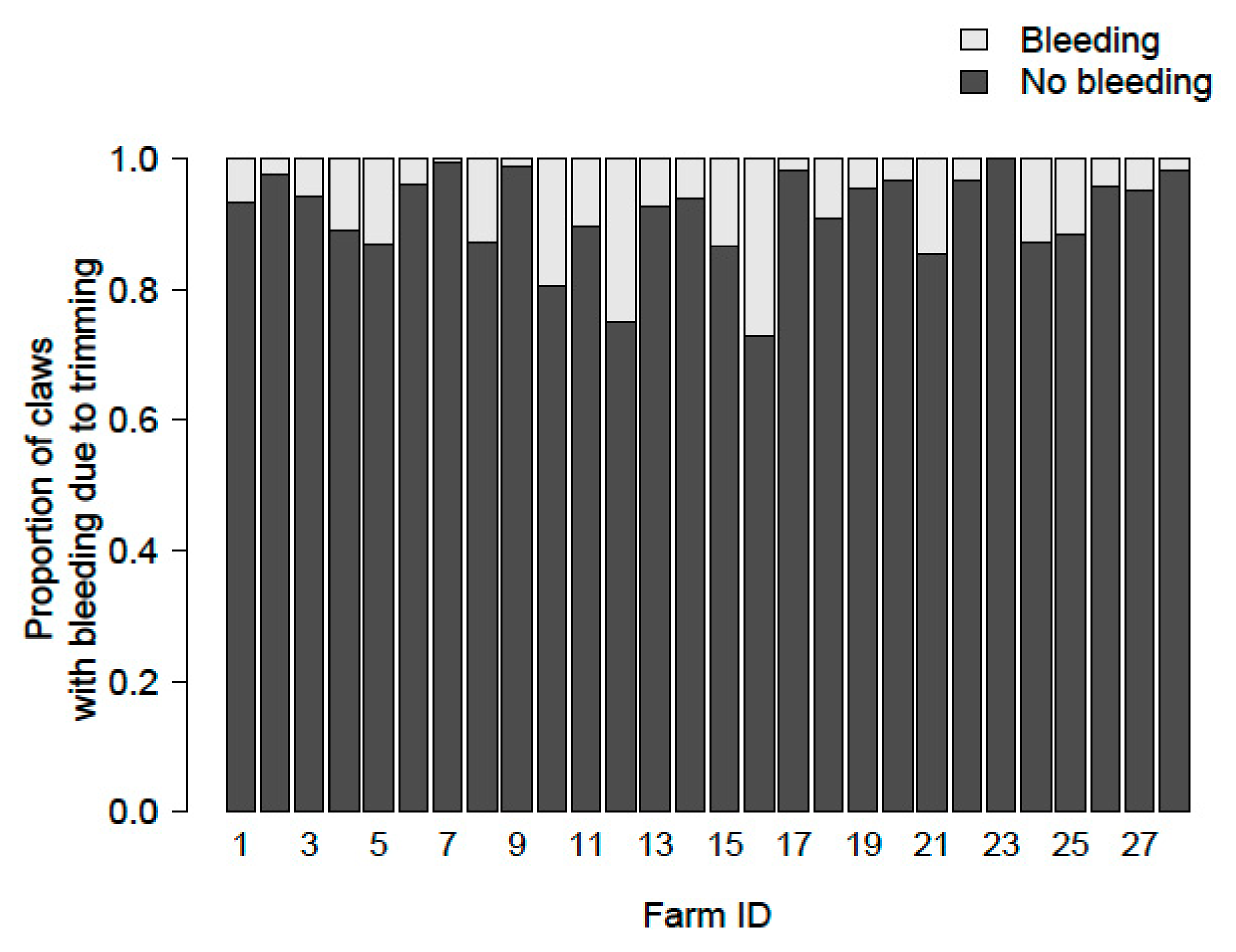
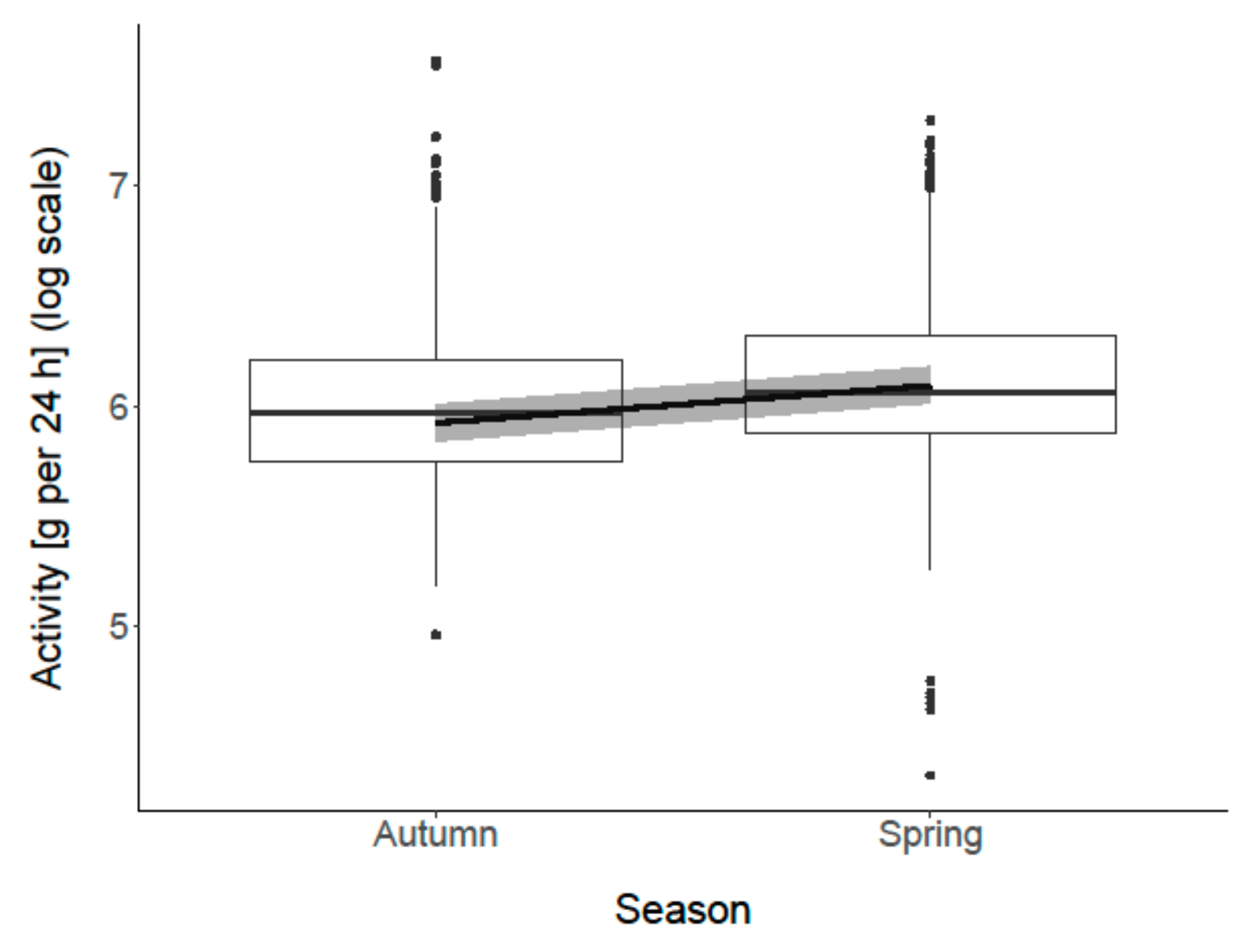
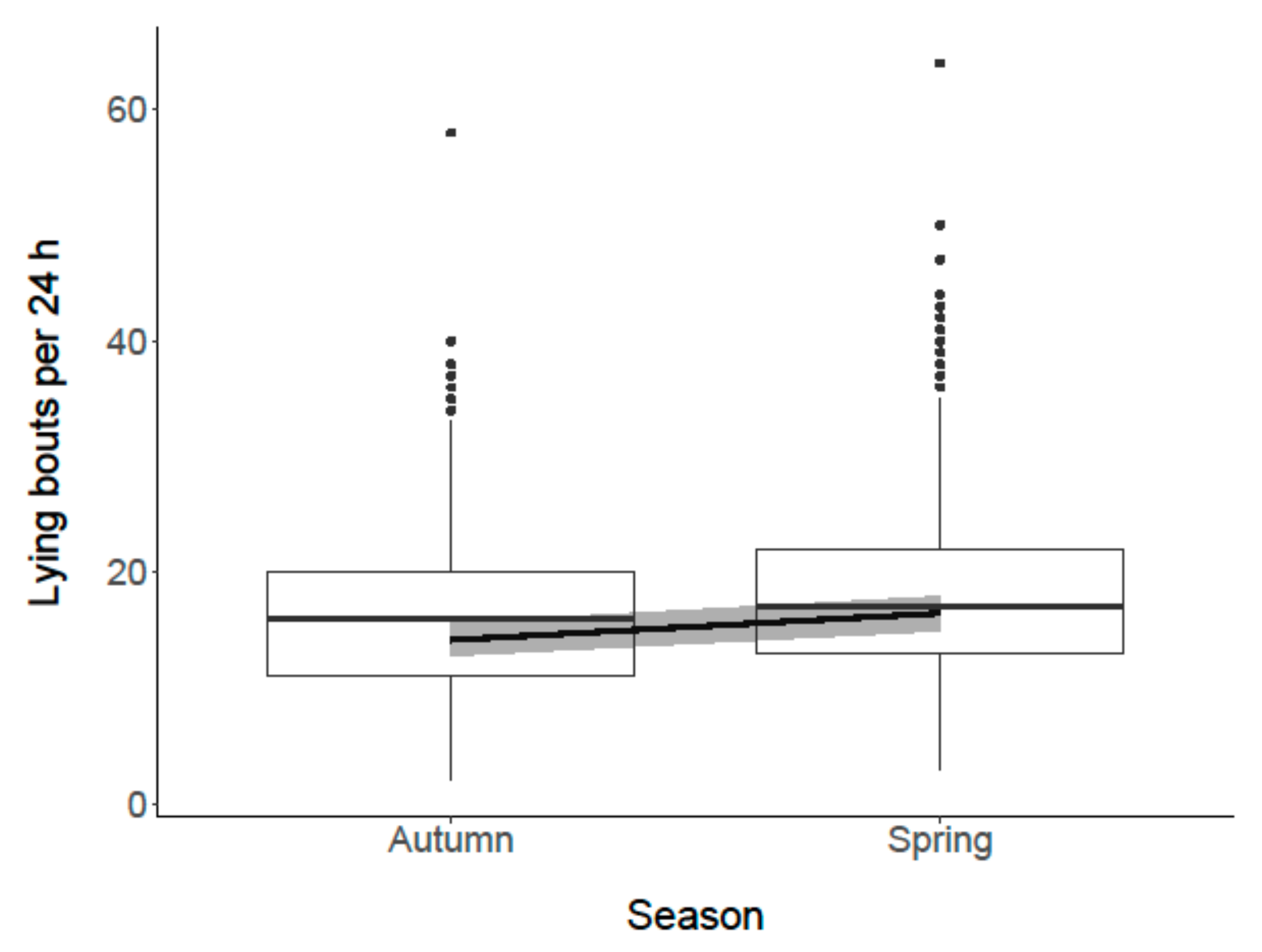
| Assessment | 0 | 1 | 2 | 3 |
|---|---|---|---|---|
| Severity of wall horn overgrowth (scores 0–2, per claw) | no overgrowth | moderate; <50% of sole surface covered by overgrown wall horn | severe; >50% of sole surface covered by overgrown wall horn | NA |
| Overall score of wall horn overgrowth | 0–16; summed-up score per animal | |||
| Direction of overgrowth | NA | to the axial side | to the abaxial side | to the axial and abaxial side |
| Origin of overgrowth | NA | abaxial wall horn | axial wall horn | axial and abaxial wall horn |
| Lesion | Definition | Picture | Literature |
|---|---|---|---|
| Bleeding (due to trimming) | The lamina is injured, with blood extravasating |  | |
| Chronic laminitis | Horizontal grooves in the wall horn, as a result of an acute laminitis with vascular injury of the corium (appears weeks up to months later) | [35,36] | |
| Foreign body | Any small object (e.g., stone, nail) that is lodged into the claw |  | [11] |
| Granulomatous lesion | Raspberry-like proliferation of the lamina | 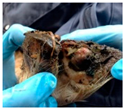 | [11,35] |
| Heel horn erosion | Erosion of the heel, in severe cases typically V-shaped, possibly extending to the corium | [37] | |
| Horn fissure | Horizontal crack in the claw wall; vertical (longitudinal) crack in the outer or dorsal claw wall |  | [37] |
| Horn separation | The wall and sole of the foot have grown apart. The space between the wall and sole varies, as does the depth of separation |  | [11,38] |
| Interdigital phlegmon | Symmetric painful swelling of the foot commonly accompanied by foul smell, with sudden onset of lameness |  | [37] |
| Sole hemorrhage | Diffused light red to yellowish discoloration; clearly distinguishable from normal colored horn |  | [37] |
| Sole/toe abscess | Abscess due to lesion and bacterial infection of the lamina |  | [35] |
| Sole/toe ulcer | Ulceration of the sole area specified according to localization such as sole ulcer, toe ulcer |  | [37] |
| Interdigital space inflammation score 1 | Mild dermatitis, without necrosis |  | |
| Interdigital space inflammation score 2 | Severe dermatitis, with necrosis | 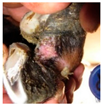 |
| Outcome Variable | Description | Fixed Effects | Random Effects |
|---|---|---|---|
| Overall score of wall horn overgrowth per animal | One score per goat (0–16) | INT (season + alpine pasture), herd size, time span since last trimming, special skills training (yes/no) | Observation < goat < farm |
| Sole hemorrhages | One finding per claw | Severity of wall horn overgrowth | Observation < season < goat < farm |
| Horn separation | Severity of wall horn overgrowth, special skills training (yes/no), pasture at time of data collection | ||
| Horn separation (excised) | Special skills training (yes/no) | ||
| Bleeding | Severity of wall horn overgrowth, special skills training (yes/no) | ||
| Total lying time in 24 h | 4 × 72 h of observation per goat | Trimming (before/after), season (spring/autumn) | Observation < trimming (before/after) < season < goat < farm |
| Number of lying bouts in 24 h | |||
| Activity in 24 h |
| Foot | Assessment | Before Trimming | After Trimming | Difference | |||
|---|---|---|---|---|---|---|---|
| Front Left | Sole length (cm) | Lateral Medial | 4.8 4.9 | (±1.57) (±1.61) | 4.3 4.4 | (±1.27) (±1.30) | 0.5 0.5 |
| Sole width (cm) | Lateral Medial | 2.2 2.4 | (±0.74) (±0.80) | 2.1 2.2 | (±0.63) (±0.65) | 0.1 0.2 | |
| Toe length (cm) | Lateral Medial | 4.0 4.0 | (±1.32) (±1.32) | 3.5 3.4 | (±1.03) (±1.00) | 0.5 0.6 | |
| Heel height (cm) | Lateral Medial | 3.8 3.7 | (±1.24) (±1.18) | 3.5 3.3 | (±1.02) (±0.97) | 0.3 0.4 | |
| Hind right | Sole length (cm) | Lateral Medial | 5.0 4.8 | (±1.66) (±1.56) | 4.3 4.2 | (±1.26) (±1.23) | 0.7 0.6 |
| Sole width (cm) | Lateral Medial | 2.1 2.1 | (±0.70) (±0.73) | 1.9 1.9 | (±0.58) (±0.59) | 0.2 0.2 | |
| Toe length (cm) | Lateral Medial | 4.0 4.0 | (±1.63) (±1.36) | 3.2 3.3 | (±0.79) (±0.98) | 0.8 0.7 | |
| Heel height (cm) | Lateral Medial | 3.3 3.2 | (±1.00) (±1.04) | 3.0 3.0 | (±0.85) (±0.85) | 0.3 0.2 | |
| Wall Horn Overgrowth | Autumn | Spring | |||
|---|---|---|---|---|---|
| Number of Claws | Percentage of Claws | Number of Claws | Percentage of Claws | ||
| Severity | Score 0 Score 1 Score2 NA | 25 1777 864 22 | 0.93% 66.11% 32.14% 0.82% | 0 985 1093 610 | 0% 36.64% 40.66% 22.70% |
| Direction | No overgrowth Axial wall Abaxial wall Both walls NA | 25 2166 9 466 22 | 0.93% 80.58% 0.33% 17.34% 0.82% | 0 1514 10 554 610 | 0% 56.32% 0.37% 20.61% 22.70% |
| Origin | No overgrowth Axial wall Abaxial wall Both walls NA | 25 18 2005 618 22 | 0.93% 0.67% 74.59% 22.99% 0.82% | 0 4 1426 648 610 | 0% 0.15% 53.05% 24.11% 22.69% |
Publisher’s Note: MDPI stays neutral with regard to jurisdictional claims in published maps and institutional affiliations. |
© 2021 by the authors. Licensee MDPI, Basel, Switzerland. This article is an open access article distributed under the terms and conditions of the Creative Commons Attribution (CC BY) license (https://creativecommons.org/licenses/by/4.0/).
Share and Cite
Sailer, L.M.; Holinger, M.; Burla, J.-B.; Wechsler, B.; Zanolari, P.; Friedli, K. Influence of Housing and Management on Claw Health in Swiss Dairy Goats. Animals 2021, 11, 1873. https://doi.org/10.3390/ani11071873
Sailer LM, Holinger M, Burla J-B, Wechsler B, Zanolari P, Friedli K. Influence of Housing and Management on Claw Health in Swiss Dairy Goats. Animals. 2021; 11(7):1873. https://doi.org/10.3390/ani11071873
Chicago/Turabian StyleSailer, Lisa Marie, Mirjam Holinger, Joan-Bryce Burla, Beat Wechsler, Patrik Zanolari, and Katharina Friedli. 2021. "Influence of Housing and Management on Claw Health in Swiss Dairy Goats" Animals 11, no. 7: 1873. https://doi.org/10.3390/ani11071873
APA StyleSailer, L. M., Holinger, M., Burla, J.-B., Wechsler, B., Zanolari, P., & Friedli, K. (2021). Influence of Housing and Management on Claw Health in Swiss Dairy Goats. Animals, 11(7), 1873. https://doi.org/10.3390/ani11071873






